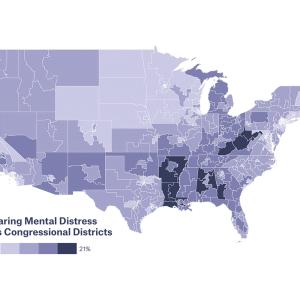First U.S. Clinical Trial of Long-Term, Extended-Release Naltrexone Shows Promise for Broader, More Effective Opioid Addiction Treatment
Opioid addiction is a rapidly escalating public health crisis in the United States. According to the Centers for Disease Control and Prevention, drug overdoses accounted for more deaths nationwide in 2013 than automobile accidents—with 71 percent of these overdose deaths attributed to opioid painkillers.
Now, new research findings could shed important light in addressing this epidemic. A study from NYU Langone Medical Center in collaboration with lead site the Center for Studies of Addiction at the Perelman School of Medicine at the University of Pennsylvania, and three other sites, published online March 30 in the New England Journal of Medicine, showed that in a randomized controlled clinical trial an extended-release version of the opioid addiction medication naltrexone (Vivitrol) significantly prevented relapses in men with previous involvement with the criminal justice system.
“We believe our study is the first of its kind to look at the real-world effectiveness of extended-release naltrexone in community settings,” says lead author Joshua D. Lee, MD, MSc, associate professor in the Department of Population Health and the Department of Medicine at NYU Langone. “It may be particularly effective with populations, such as recently released prisoners, who typically don’t have access to other evidence-based daily medications for opiate disorders, like methadone or buprenorphine.”
Positive Results Could Point to Expanded Use in Treatment
To help address the nationwide opiate addiction epidemic, the U.S. Senate recently passed a broad drug prevention and treatment bill. This comes on the heels of President Obama’s State of the Union address in January, in which he highlighted bipartisan reforms to the criminal justice system that will help those who are addicted to opioid painkillers and heroin.
The findings of the study could have broader impact on how the medical community addresses opiate addiction outside of the patient populations examined in this study, the researchers say.
“The health, economic, and social consequences of incarceration are profound and enduring, and a substantial proportion of that is fueled by substance use,” says co-author Marc Gourevitch, MD, MPH, the Muriel G. and George W. Singer Professor and founding chair of the Department of Population Health. “If we don’t aggressively offer effective treatment options as part of incarceration, we’re severely missing the boat—and jeopardizing our communities. This type of study of medication-assisted treatment is critical for beginning to turn that tide.”
Extended-release naltrexone is the most recently FDA-approved product for the treatment of opiate addiction, and the only product labeled for prevention of relapse. A daily, oral form of naltrexone has been on the market since 1994—but opioid cravings present challenges to daily compliance. Extended-release naltrexone, approved by the FDA in 2010, requires only a once-monthly injection, making it an important option.
Opioid Relapse Lessened with Naltrexone Intervention
The new study was designed to determine if six monthly injections of extended-release naltrexone could blunt relapse rates in opioid-addicted men who were recently released from prison, on probation or parole, or with other criminal justice involvement. Injections were administered at five locations in four major U.S. cities: two in New York, and one each in Baltimore, Providence, and Philadelphia.
A total of 153 participants were given monthly injections of extended-release naltrexone, while 155 did not receive the drug. Both groups received motivational counseling and referrals to community treatment. There was no placebo injection.
After six monthly injections, 64 percent (99) of participants in the control group relapsed, while only 43 percent (66) relapsed in the treatment group. In addition, members of the treatment group who did relapse used significantly less heroin and other opioids than those in the control group. Importantly, across the six-month study period, there were no overdoses in the treatment group, compared with five in the control group.
The researchers extended follow-up observations for one year after the extended-release naltrexone treatment had ended, and found two additional overdoses in the control group and none in the treatment group. However, by the end of the one-year follow-up period, both groups were using opioids at a similar rate. Further studies are needed to determine if there is a benefit to using extended-release naltrexone therapy longer than six months.
“The use of extended-release naltrexone and other medications, including buprenorphine and methadone, in community treatment and criminal justice settings has lagged behind the public health need for effective treatments to reduce relapse, risk of overdose, and burdens on the criminal justice system,” says Dr. Lee. “Our findings highlight its effectiveness for treating opioid addiction, particularly among patients not likely to access buprenorphine or methadone, and shine a light on the need for evidence-based medications in all communities.”
In addition to Dr. Gourevitch, and Dr. Lee study co-authors include Peter D. Friedmann, MD, MPH, of the National Institute on Drug Abuse; Timothy W. Kinlock, PhD, of the University of Baltimore & Friends Research Institute; Edward V. Nunes, MD, of Columbia University College of Physicians & Surgeons; Randall A. Hoskinson, Jr. and Donna Wilson, MS, of Rhode Island Hospital and Alpert Medical School of Brown University; Ryan McDonald, MA, and John Rotrosen, MD, of NYU Langone Medical Center; Michael Gordon, DPA, of Friends Research Institute; Marc Fishman, MD, of Friends Research Institute and Maryland Treatment Centers; Donna T. Chen, MD, MPH, and Richard J. Bonnie, LLB, of University of Virginia; James W. Cornish, MD, and Tamara Y. Boney, MS, CCRC, and Charles P. O’Brien, MD, PhD, of the University of Pennsylvania; and Sean Murphy, PhD, at Washington State University.
The study was supported by the National Institute on Drug Abuse (NIDA) through a collaborative clinical trial mechanism, PAR-07-232 (R01DA024549, to Dr. Friedmann; R01DA024550, to Dr. Kinlock; R01DA024553, to Dr. O’Brien; R01DA024554, to Dr. Nunes; and R01DA024555, to Dr. Lee), and additional support (K24DA022412, to Dr. Nunes). Trial medication was provided in-kind from an investigator-initiated grant from Alkermes. Funding from the Dana Foundation to Dr. O’Brien supported the conduct of a five-site pilot study.
Disclosure: Dr. Lee reports receiving grant support and study medication from Alkermes and study medication from Indivior (formerly Reckitt Benckiser).

